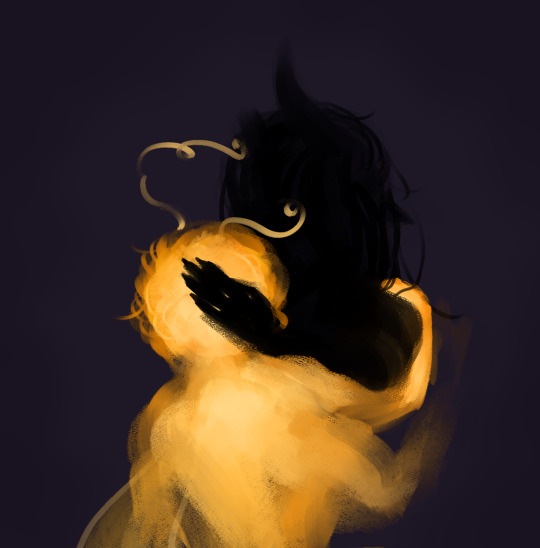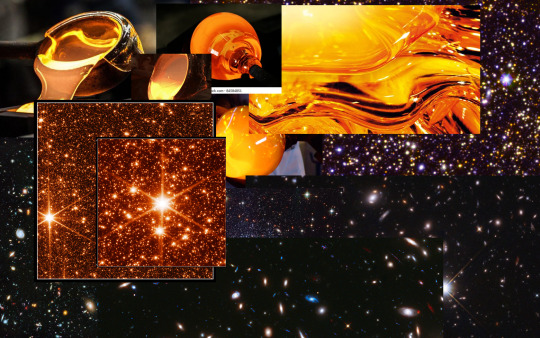#1e 0657-56
Explore tagged Tumblr posts
Photo

THE BULLET CLUSTER This is a composite image of the matter in the Bullet Cluster, a galaxy cluster also known as 1E 0657-56. The Bullet Cluster lies 3.4 billion light-years away and is one of the hottest known clusters of galaxies.
The cluster’s individual galaxies can be seen in the optical image data, but their total mass equates to far less than the mass of the cluster's two clouds of hot and luminous x-ray emitting gas shown in red. The distribution of dark matter within the cluster is shown by the blue hues, representing more mass than the optical galaxies and the x-ray gas combined. Dark matter is usually invisible to telescopic views, but in this case was mapped by gravitational lensing of the background galaxies. The bullet-shaped cloud of gas at the right was distorted as a shock front during a collision between two galaxy clusters that created the larger Bullet Cluster itself. The dark matter present has only interacted with the cluster gas through gravity. This clear separation of dark matter and gas clouds provide the best evidence to date that dark matter exists. -TEL How composite images are made: http://on.fb.me/YP4biZ http://apod.nasa.gov/apod/ap060824.html Composite Credit: X-ray: NASA/CXC/CfA/ M.Markevitch et al. Lensing Map: NASA/STScI; ESO WFI; Magellan/U.Arizona/ D.Clowe et al. Optical: NASA/STScI; Magellan/U.Arizona/D.Clowe et al.
#bullet cluster#galaxy cluster#1E 0657-56#space#science#gas#x-ray#shock#the universe#the real universe#isuniverse
57 notes
·
View notes
Photo


𝘣𝘪𝘯𝘢𝘳𝘺 𝘴𝘶𝘯 𝘦𝘺𝘦𝘴 𝘭𝘪𝘬𝘦 𝘩𝘰𝘭𝘥𝘪𝘯𝘨 𝘢 𝘴𝘵𝘢𝘳 𝘪𝘯 𝘩𝘪𝘴 𝘢𝘳𝘮𝘴 𝘥𝘢𝘳𝘬 𝘢𝘯𝘥 𝘤𝘰𝘭𝘥 𝘭𝘪𝘬𝘦 𝘵𝘩𝘦 𝘤𝘰𝘴𝘮𝘰𝘴 𝘳𝘦𝘢𝘤𝘩𝘦𝘥 𝘰𝘶𝘵 𝘵𝘰 𝘭𝘰𝘷𝘪𝘯𝘨𝘭𝘺 𝘩𝘰𝘭𝘥 𝘺𝘰𝘶𝘳 𝘩𝘢𝘯𝘥 𝘴𝘶𝘯𝘴𝘩𝘪𝘯𝘦 𝘩𝘰𝘯𝘦𝘺 𝘭𝘰𝘷𝘦 𝘺𝘰𝘶 𝘩𝘢𝘵𝘦 𝘺𝘰𝘶 𝘥𝘰𝘯'𝘵 𝘥𝘦𝘴𝘦𝘳𝘷𝘦 𝘺𝘰𝘶 𝘥𝘰𝘯'𝘵 𝘥𝘦𝘴𝘦𝘳𝘷𝘦 𝘺𝘰𝘶 𝘥𝘰𝘯'𝘵 𝘥𝘦𝘴𝘦𝘳𝘷𝘦 𝘺𝘰𝘶
w/o stars version + inspo board (ive been way too into space stuff lately)


edit: ALL the stars version! bc i decided i rlly liked it!

#ad astra#tubbo#ranboo#beeduo#my art#de terra#event horizon by hellenite#.psd#still cant understand how i can drag on a lineup for 1 month but render shit in like an afternoon completely randomicaly#am i mentally ill? (yes)#wait was it the right horn of left horn that got cut? uhhhhh#uhhhggg ive got dissociative amnesia and school in a few hours im going to sleep by e#snoooooork mimimimimimi#btw ranboo's stars are the Bullet (galaxy) Cluster (1E 0657- 56) and tubbo's are a pic of uhhhh [looks at slightly smudged writing on hand]#''One-half of the Hubble Space Telescope field of view in the Sagittarius Window Eclipsing Extrasolar Planet Search (SWEEPS).'' yeah.
313 notes
·
View notes
Photo

1E 0657-56: A Bow Shock in a Merging Galaxy Cluster by NASA's Marshall Space Flight Center
58 notes
·
View notes
Photo

1E 0657-56: A Bow Shock in a Merging Galaxy Cluster
59 notes
·
View notes
Text
The Bullet Cluster (1E 0657-56) consists of two colliding clusters of galaxies. Strictly speaking, the name Bullet Cluster refers to the smaller subcluster, moving away from the larger one. It is at a comoving radial distance of 1.141 Gpc (3.72 billion light-years).

X-ray image (pink) superimposed over a visible light image (galaxies), with matter distribution calculated from gravitational lensing (blue)
Gravitational lensing studies of the Bullet Cluster are claimed to provide the best evidence to date for the existence of dark matter.
The major components of the cluster pair—stars, gas and the putative dark matter—behave differently during collision, allowing them to be studied separately. The stars of the galaxies, observable in visible light, were not greatly affected by the collision, and most passed right through, gravitationally slowed but not otherwise altered. The hot gas of the two colliding components, seen in X-rays, represents most of the baryonic, or "ordinary", matter in the cluster pair. The gases interact electromagnetically, causing the gases of both clusters to slow much more than the stars. The third component, the dark matter, was detected indirectly by the gravitational lensing of background objects. In theories without dark matter, such as Modified Newtonian dynamics (MOND), the lensing would be expected to follow the baryonic matter; i.e. the X-ray gas. However, the lensing is strongest in two separated regions near (possibly coincident with) the visible galaxies. This provides support for the idea that most of the gravitation in the cluster pair is in the form of two regions of dark matter, which bypassed the gas regions during the collision. This accords with predictions of dark matter as only gravitationally interacting, other than weakly interacting.
And that's one of the most exciting things I saw in my life.
1 note
·
View note
Video
Galaxy Cluster 1E 0657-56: NASA Finds Direct Proof of Dark Matter by NASA's Marshall Space Flight Center Via Flickr: This composite image shows the galaxy cluster 1E 0657-56, also known as the "bullet cluster." This cluster was formed after the collision of two large clusters of galaxies, the most energetic event known in the universe since the Big Bang. Hot gas detected by Chandra in X-rays is seen as two pink clumps in the image and contains most of the "normal," or baryonic, matter in the two clusters. The bullet-shaped clump on the right is the hot gas from one cluster, which passed through the hot gas from the other larger cluster during the collision. An optical image from Magellan and the Hubble Space Telescope shows the galaxies in orange and white. The blue areas in this image show where astronomers find most of the mass in the clusters. The concentration of mass is determined using the effect of so-called gravitational lensing, where light from the distant objects is distorted by intervening matter. Most of the matter in the clusters (blue) is clearly separate from the normal matter (pink), giving direct evidence that nearly all of the matter in the clusters is dark. The hot gas in each cluster was slowed by a drag force, similar to air resistance, during the collision. In contrast, the dark matter was not slowed by the impact because it does not interact directly with itself or the gas except through gravity. Therefore, during the collision the dark matter clumps from the two clusters moved ahead of the hot gas, producing the separation of the dark and normal matter seen in the image. If hot gas was the most massive component in the clusters, as proposed by alternative theories of gravity, such an effect would not be seen. Instead, this result shows that dark matter is required. Image credit: X-ray: NASA/CXC/CfA/M.Markevitch et al.; Optical: NASA/STScI; Magellan/U.Arizona/D.Clowe et al.; Lensing Map: NASA/STScI; ESO WFI; Magellan/U.Arizona/D.Clowe et al. Read more More about the Chandra X-ray Observatory NASA Media Usage Guidelines
#NASA#NASA's#Marshall#Space#Flight#Center#MSFC#Chandra#X-Ray#Observatory#CXO#Solar#System#Beyond#galaxy#stars#astronomy#astrophysics#dark#matter#Now Playing#1st#April#2019#April 1st 2019
1 note
·
View note
Photo

Giant atoms could help unveil ‘dark matter’ and other cosmic secrets : The universe is an astonishingly secretive place. Mysterious substances known as dark matter and dark energy account for some 95% of it. Despite huge effort to find out what they are, we simply don’t know. We know dark matter exists because of the gravitational pull of galaxy clusters – the matter we can see in a cluster just isn’t enough to hold it together by gravity. So there must be some extra material there, made up by unknown particles that simply aren’t visible to us. Several candidate particles have already been proposed. Scientists are trying to work out what these unknown particles are by looking at how they affect the ordinary matter we see around us. But so far it has proven difficult, so we know it interacts only weakly with normal matter at best. Now my colleague Benjamin Varcoe and I have come up with a new way to probe dark matter that may just prove successful: by using atoms that have been stretched to be 4,000 times larger than usual. Read more at : http://ift.tt/2ijNXvy Image credits : Composite image showing the galaxy cluster 1E 0657-56. Chandra X-Ray Observatory/NASA http://ift.tt/2jvykBh
0 notes
Photo

Galaxy Cluster 1E 0657-56: NASA Finds Direct Proof of Dark Matter by NASA's Marshall Space Flight Center
141 notes
·
View notes
Photo
This view of the Bullet Cluster, located about 3.8 billion light years from Earth, combines an image from NASA's Chandra X-ray Observatory with optical data from the Hubble Space Telescope and the Magellan telescope in Chile. This cluster, officially known as 1E 0657-56, was formed after the violent collision of two large clusters of galaxies. It has become an extremely popular object for astrophysical research, including studies of the properties of dark matter and the dynamics of million-degree gas.
In the latest research, the Bullet Cluster has been used to search for the presence of antimatter leftover from the very early Universe. Antimatter is made up of elementary particles that have the same masses as their corresponding matter counterparts - protons, neutrons and electrons - but the opposite charges and magnetic properties.
The optical image shows the galaxies in the Bullet Cluster and the X-ray image (red) reveals how much hot gas has collided. If some of the gas from either cluster has particles of antimatter, then there will be annihilation between the matter and antimatter and the X-rays will be accompanied by gamma rays.
The observed amount of X-rays from Chandra and the non-detection of gamma rays from NASA's Compton Gamma Ray Observatory show that the antimatter fraction in the Bullet Cluster is less than three parts per million. Moreover, simulations of the Bullet Cluster merger show that these results rule out any significant amounts of antimatter over scales of about 65 million light years, an estimate of the original separation of the two colliding clusters.
Credit X-ray: NASA/CXC/CfA/M.Markevitch et al.; Optical: NASA/STScI; Magellan/U.Arizona/D.Clowe et al.
https://chandra.harvard.edu/photo/2008/bullet/

Searching for Primordial Antimatter by NASA’s Marshall Space Flight Center
270 notes
·
View notes
Video
Searching for Primordial Antimatter by NASA's Marshall Space Flight Center Via Flickr: This view of the Bullet Cluster, located about 3.8 billion light years from Earth, combines an image from NASA's Chandra X-ray Observatory with optical data from the Hubble Space Telescope and Magellan telescope in Chile. This cluster, officially known as 1E 0657-56, was formed after the violent collision of two large clusters of galaxies. It has become an extremely popular object for astrophysical research, including studies of the properties of dark matter and the dynamics of million-degree gas. In the latest research, the Bullet Cluster has been used to search for the presence of antimatter leftover from the very early Universe. Antimatter is made up of elementary particles that have the same masses as their corresponding matter counterparts -- protons, neutrons and electrons -- but the opposite charges and magnetic properties. Image credit: X-ray: NASA/CXC/CfA/M.Markevitch et al. Optical: NASA/STScI; Magellan/U.Arizona/D.Clowe et al. Read more More about the Chandra X-ray Observatory NASA Media Usage Guidelines
#Bullet Cluster#NASA#NASA's Marshall Space Flight Center#NASA Marshall#Marshall#MSFC#Chandra X-Ray Observatory#CXO#Hubble Space Telescope#HST#Solar System & Beyond#stars#astronomy#astrophysics#antimatter#X-ray#Now Playing#4th#June#2019#June 4th 2019
0 notes
